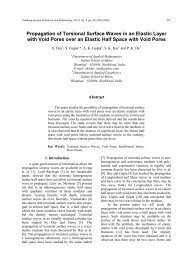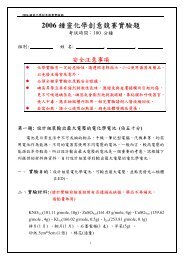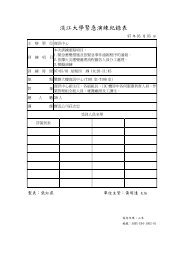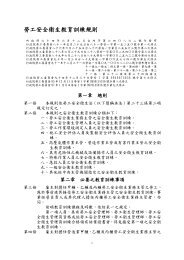CHAPTER 14 Acids and Bases
CHAPTER 14 Acids and Bases
CHAPTER 14 Acids and Bases
You also want an ePaper? Increase the reach of your titles
YUMPU automatically turns print PDFs into web optimized ePapers that Google loves.
<strong>CHAPTER</strong> <strong>14</strong><strong>Acids</strong> <strong>and</strong> <strong>Bases</strong>1. For the equilibrium that exists in an aqueous solution of nitrous acid (HNO 2 , a weakacid), the equilibrium constant expression is:a) K = [H+ ][NO – 2 ][HNO 2 ]b) K = [H+ ][N][O] 2[HNO 2 ]c) K = [H + ][NO 2 – ]d) K = [H+ ] 2 [NO 2 – ][HNO 2 ]e) none of theseANS: a) K = [H+ ][NO 2 – ][HNO 2 ]PAGE: <strong>14</strong>.12. Which of the following is a conjugate acid/base pair?a) HCl/OCl -b) H 2 SO 4 /SO 2- 4c) NH + 4 /NH 3d) H 3 O + /OH -e) none of theseANS: c) NH 4+ /NH 3 PAGE: <strong>14</strong>.13. The equilibrium constant for the reactionA – + H + HAis called:a) K ab) K bc)1K ad)K wK be) K w K aANS: c)1K aPAGE: <strong>14</strong>.1321 © Houghton Mifflin Company. All rights reserved.
<strong>CHAPTER</strong> <strong>14</strong><strong>Acids</strong> <strong>and</strong> <strong>Bases</strong>4. For the stepwise dissociation of aqueous H 3 PO 4 , which of the following is not aconjugate acid–base pair?a) HPO 2– 4 <strong>and</strong> PO 3– 4b) H 3 PO 4 <strong>and</strong> H 2 PO – 4c) H 2 PO – 4 <strong>and</strong> HPO 2– 4d) H 2 PO – 4 <strong>and</strong> PO 3– 4e) H 3 O + <strong>and</strong> H 2 OANS: d) H 2 PO 4– <strong>and</strong> PO4 3– PAGE: <strong>14</strong>.1,75. What is the equilibrium constant for the following reaction?N – 3 + H 3 O + HN 3 + H 2 OThe K a value for HN 3 = 1.9 × 10 –5 .a) 5.3 × 10 –10b) 1.9 × 10 –9c) 1.9 × 10 –5d) 5.3 × 10 4e) 1.9 × 10 9ANS: d) 5.3 × 10 4 PAGE: <strong>14</strong>.16. The hydrogen sulfate or bisulfate ion HSO – 4 can act as either an acid or a base in watersolution. In which of the following equations does HSO – 4 act as an acid?a) HSO – 4 + H 2 O → H 2 SO 4 + OH –b) HSO – 4 + H 3 O + → SO 3 + 2H 2 Oc) HSO – 4 + OH – → H 2 SO 4 + O 2–d) HSO – 4 + H 2 O → SO 2– 4 + H 3 O +e) none of theseANS: d) HSO 4– + H 2 O → SO 42– + H 3 O + PAGE: <strong>14</strong>.1,2322 © Houghton Mifflin Company. All rights reserved.
<strong>CHAPTER</strong> <strong>14</strong><strong>Acids</strong> <strong>and</strong> <strong>Bases</strong>7. Using the following K a values, indicate the correct order of base strength.HNO 2 K a = 4.0 × 10 –4HF K a = 7.2 × 10 –4HCN K a = 6.2 × 10 –10a) CN – > NO – 2 > F – > H 2 O > Cl –b) Cl – > H 2 O > F – > NO – 2 > CN –c) CN – > F – > NO – 2 > Cl – > H 2 Od) H 2 O > CN – > NO – 2 > F – > Cl –e) none of theseANS: a) CN – > NO 2– > F – > H 2 O > Cl – PAGE: <strong>14</strong>.28. At 0°C, the ion-product constant of water, K w , is 1.2 × 10 –15 . The pH of pure waterat 0°C is:a) 7.00b) 6.88c) 7.56d) 7.46e) none of theseANS: d) 7.46 PAGE: <strong>14</strong>.2,39. The equilibrium constants (K a ) for HCN <strong>and</strong> HF in H 2 O at 25°C are 6.2 × 10 –10 <strong>and</strong>7.2 × 10 –4 , respectively. The relative order of base strengths is:a) F – > H 2 O > CN –b) H 2 O > F – > CN –c) CN – > F – > H 2 Od) F – > CN – > H 2 Oe) none of theseANS: c) CN – > F – > H 2 O PAGE: <strong>14</strong>.2© Houghton Mifflin Company. All rights reserved. 323
<strong>CHAPTER</strong> <strong>14</strong><strong>Acids</strong> <strong>and</strong> <strong>Bases</strong>10. Given the following acids <strong>and</strong> Ka values:HClO 4 HOAc HCN HF1 × 10 7 1.76 × 10 –5 4.93 × 10 –10 3.53 × 10 –4which shows the conjugate bases listed by increasing strength?a) CN – , F – , OAc – , ClO – 4b) CN – , OAc – , F – , ClO – 4c) CN – , ClO 4– , F – , OAc –d) ClO 4– , OAc – , CN – , F –e) ClO – 4 , F – , OAc – , CN –ANS: e) ClO 4 – , F – , OAc – , CN – PAGE: <strong>14</strong>.211. The conjugate base of a weak acid isa) a strong baseb) a weak basec) a strong acidd) a weak acide) none of theseANS: b) a weak base PAGE: <strong>14</strong>.212. Which of the following is the equilibrium constant expression for the dissociation of theweak acid HOCl?a) K = [H+ ][OCl – ][HOCl]b) K = [H + ][OCl – ]c) K =[HOCl][H + ][OCl – ]d) K = [H+ ][O 2– ][Cl – ][HOCl]e) none of theseANS: a) K = [H+ ][OCl – ][HOCl]PAGE: <strong>14</strong>.1,213–<strong>14</strong>. The following three equations represent equilibria that lie far to the right.HNO 3 (aq) + CN – (aq) HCN(aq) + NO – 3 (aq)HCN(aq) + OH – (aq) H 2 O(l) + CN – (aq)H 2 O(l) + CH 3 O – (aq) CH 2 OH(aq) + OH – (aq)324 © Houghton Mifflin Company. All rights reserved.
<strong>CHAPTER</strong> <strong>14</strong><strong>Acids</strong> <strong>and</strong> <strong>Bases</strong>13. Identify the strongest acid.a) HCNb) HNO 3c) H 2 Od) OH –e) CH 3 OHANS: b) HNO 3 PAGE: <strong>14</strong>.2<strong>14</strong>. Identify the strongest base.a) CH 3 O –b) CH 3 OHc) CN –d) H 2 Oe) NO – 3ANS: a) CH 3 O – PAGE: <strong>14</strong>.215. Given that the K a for HOCl is 3.5 x 10 -8 , calculate the K value for the reaction of HOClwith OH - .a) 3.5 x 10 6b) 3.5 x 10 -8c) 3.5 x 10 -22d) 2.9 x 10 -7e) none of theseANS: a) 3.5 x 10 6 PAGE: <strong>14</strong>.2,6,816. Calculate the [H + ] in a solution that has a pH of 11.70.a) 2.3 Mb) 11.7 Mc) 5.0 × 10 –3 Md) 2.0 × 10 –12 Me) none of theseANS: d) 2.0 × 10 –12 M PAGE: <strong>14</strong>.317. Calculate the [H + ] in a solution that has a pH of 2.30.a) 2.3 Mb) 11.7 Mc) 5.0 × 10 –3 Md) 2.0 × 10 –12 Me) none of theseANS: c) 5.0 × 10 –3 M PAGE: <strong>14</strong>.3© Houghton Mifflin Company. All rights reserved. 325
<strong>CHAPTER</strong> <strong>14</strong><strong>Acids</strong> <strong>and</strong> <strong>Bases</strong>18. The pH of a solution at 25°C in which [OH – ] = 3.4 × 10 –5 M is:a) 4.5b) 10.5c) 9.5d) 6.3e) none of theseANS: c) 9.5 PAGE: <strong>14</strong>.319. Consider the reaction HNO 2 (aq) + H 2 O(l) H 3 O + (aq) + NO – (aq). Which species isthe conjugate base?a) HNO 2 (aq)b) H 2 O(l)c) H 3 O + (aq)d) NO – (aq)e) Two of theseANS: e) Two of these PAGE: <strong>14</strong>.120. In which of the following reactions does the H 2 PO - 4 ion act as an acid?a) H 3 PO 4 + H 2 O → H 3 O + + H 2 PO – 4b) H 2 PO – 4 + H 2 O → H 3 O + + HPO 2- 4c) H 2 PO – 4 + OH – → H 3 PO 4 + O 2-d) The ion cannot act as an acid.e) Two of theseANS: b) H 2 PO 4– + H 2 O → H 3 O + + HPO 42- PAGE: <strong>14</strong>.121. In deciding which of two acids is the stronger, one must know:a) the concentration of each acid solutionb) the pH of each acid solutionc) the equilibrium constant of each acidd) all of thesee) both a <strong>and</strong> c must be knownANS: c) the equilibrium constant of each acid PAGE: <strong>14</strong>.222. Which of the following is not true for a solution at 25°C that has a hydroxideconcentration of 2.5 × 10 –6 M?a) K w = 1 × 10 –<strong>14</strong>b) The solution is acidic.c) The solution is basic.d) The [H] is 4 × 10 –9 M.e) The K w is independent of what the solution contains.ANS: c) The solution is basic. PAGE: <strong>14</strong>.2326 © Houghton Mifflin Company. All rights reserved.
<strong>CHAPTER</strong> <strong>14</strong><strong>Acids</strong> <strong>and</strong> <strong>Bases</strong>23. Calculate the [H + ] in a solution that has a pH of 9.7.a) 2.0 × 10 –10 Mb) 5.0 × 10 –5 Mc) 3.6 × 10 –9 Md) 9.7 × 10 –9 Me) 6.3 × 10 –10 MANS: a) 2.0 × 10 –10 M PAGE: <strong>14</strong>.324. Calculate the pH of 0.250 M HNO 3 (aq).a) 0.600b) 2.50c) 12.0d) 1.20e) 13.4ANS: a) 0.600 PAGE: <strong>14</strong>.425. Solid calcium hydroxide is dissolved in water until the pH of the solution is 10.94. Thehydroxide ion concentration [OH – ] of the solution is:a) 1.1 × 10 –11 Mb) 3.06 Mc) 8.7 × 10 –4 Md) 1.0 × 10 –<strong>14</strong> Me) none of theseANS: c) 8.7 × 10 –4 M PAGE: <strong>14</strong>.326. As water is heated, its pH decreases. This means thata) the water is no longer neutralb) [H + ] > [OH - ]c) [OH - ] > [H + ]d) a <strong>and</strong> b are correcte) none of theseANS: e) none of these PAGE: <strong>14</strong>.327. Which of the following indicates the most basic solution?a) [H + ] = 1 × 10 –10 Mb) pOH = 6.7c) [OH – ] = 7 × 10 –5 Md) pH = 4.2e) At least two of the solutions are equally basic.ANS: a) [H + ] = 1 × 10 –10 M PAGE: <strong>14</strong>.3© Houghton Mifflin Company. All rights reserved. 327
<strong>CHAPTER</strong> <strong>14</strong><strong>Acids</strong> <strong>and</strong> <strong>Bases</strong>33. Determine the molarity of a solution of the weak acid HClO 2 (K a = 1.10 × 10 –2 ) if it has apH of 1.25.a) 0.287 Mb) 1.23 Mc) 0.819 Md) 3.17 Me) 1.52 MANS: a) 0.287 M PAGE: <strong>14</strong>.534–35. The following questions refer to a solution that contains 1.00 M hydrofluoric acid, HF(K a = 7.2 × 10 –4 ), <strong>and</strong> 3.00 M hydrocyanic acid, HCN (K a = 6.2 × 10 –10 ).34. What is the pH of this mixture of weak acids?a) 0.00b) 1.57c) 3.<strong>14</strong>d) 4.37e) 9.21ANS: b) 1.57 PAGE: <strong>14</strong>.535. Determine the [CN – ] at equilibrium.a) 4.31 × 10 –5 Mb) 4.28 × 10 –7 Mc) 6.9 × 10 –8 Md) 6.2 × 10 –10 Me) none of theseANS: c) 6.9 × 10 –8 M PAGE: <strong>14</strong>.536. How many moles of benzoic acid, a monoprotic acid with K a = 6.4 × 10 –5 , must bedissolved in 500. mL of H 2 O to produce a solution with pH = 2.50?a) 1.6 × 10 –1b) 2.0 × 10 –2c) 7.8 × 10 –2d) 0.50e) none of theseANS: c) 7.8 × 10 –2 PAGE: <strong>14</strong>.5© Houghton Mifflin Company. All rights reserved. 329
<strong>CHAPTER</strong> <strong>14</strong><strong>Acids</strong> <strong>and</strong> <strong>Bases</strong>37. Calculate the [H + ] in a 0.010 M solution of HCN, K a = 6.2 × 10 –10 .a) 1.0 × 10 –7 Mb) 2.5 × 10 –6 Mc) 3.6 × 10 –3 Md) 6.2 × 10 –10 Me) none of theseANS: b) 2.5 × 10 –6 M PAGE: <strong>14</strong>.538. In a solution prepared by dissolving 0.100 mole of propionic acid in enough water tomake 1.00 L of solution, the pH is observed to be 1.35. The K a for propionic acid(HC 3 H 5 O 2 ) is:a) 2.0 × 10 –2b) 3.6 × 10 –2c) 4.5 × 10 –2d) 5.0 × 10 –12e) none of theseANS: b) 3.6 × 10 –2 PAGE: <strong>14</strong>.539. A solution of 2.5 M weak acid is 0.52% ionized. What is the K a value of this acid?a) 6.8 x 10 -5b) 1.1 x 10 -5c) 0.11d) 1.3 x 10 -2e) none of theseANS: a) 6.8 x 10 -5 PAGE: <strong>14</strong>.540. A solution of 8.0 M formic acid (HCOOH) is 0.47% ionized. What is the K a of formicacid?a) 3.4 × 10 –8b) 1.8 × 10 –4c) 6.9 × 10 –6d) 3.8 × 10 –2e) need more dataANS: b) 1.8 × 10 –4 PAGE: <strong>14</strong>.5330 © Houghton Mifflin Company. All rights reserved.
<strong>CHAPTER</strong> <strong>14</strong><strong>Acids</strong> <strong>and</strong> <strong>Bases</strong>41. The pH of a 0.100 M solution of an aqueous weak acid (HA) is 3.20. The K a for theweak acid is:a) 6.3 × 10 –4b) 7.2 × 10 –5c) 4.0 × 10 –6d) 3.2e) none of theseANS: c) 4.0 × 10 –6 PAGE: <strong>14</strong>.542. Saccharin is a monoprotic acid. If the pH of a 1.50 × 10 –2 M solution of this acid is 5.53,what is the K a of saccharin?a) 2.0 × 10 –4b) 2.9 × 10 –6c) 5.8 × 10 –10d) 8.4 × 10 –12e) none of theseANS: c) 5.8 × 10 –10 PAGE: <strong>14</strong>.543. The pH of a 0.13 M solution of a weak monoprotic acid, HA, is 2.92. Calculate the K a forthis acid.a) 0.13b) 1.2 × 10 –3c) 1.4 × 10 –6d) 1.1 × 10 –5e) 1.3 × 10 –10ANS: d) 1.1 × 10 –5 PAGE: <strong>14</strong>.544. A monoprotic weak acid when dissolved in water is 0.92% dissociated <strong>and</strong> produces asolution with a pH of 3.42. Calculate the K a of the acid.a) 1.4 x 10 -7b) 2.8 x 10 -3c) 3.5 x 10 -6d) Need to know the initial concentration of the acid.e) None of these.ANS: c) 3.5 x 10 -6 PAGE: <strong>14</strong>.5© Houghton Mifflin Company. All rights reserved. 331
<strong>CHAPTER</strong> <strong>14</strong><strong>Acids</strong> <strong>and</strong> <strong>Bases</strong>45. If an acid, HA, is 10.0% dissociated in a 1.0 M solution, what is the K a for this acid?a) 9.1 × 10 –2b) 1.1 × 10 –2c) 8.1 × 10 –1d) 6.3 × 10 –2e) none of theseANS: b) 1.1 × 10 –2 PAGE: <strong>14</strong>.546. Calculate the pH of a 0.10 M solution of HOCl, K a = 3.5 × 10 –8 .a) 4.23b) 8.46c) 3.73d) 1.00e) 3.23ANS: a) 4.23 PAGE: <strong>14</strong>.547. Calculate the pOH of a 0.80 M solution of acetic acid (K a = 1.8 × 10 –5 ).a) 9.25b) 2.42c) 4.74d) 11.58e) 7.87ANS: d) 11.58 PAGE: <strong>14</strong>.548. The pK a of HOCl is 7.5. Calculate the pH of a 0.5 M solution of HOCl.a) 7.5b) 6.5c) 3.9d) 10.1e) 0.3ANS: c) 3.9 PAGE: <strong>14</strong>.549. When 2.0 × 10 –2 mol of nicotinic acid (a monoprotic acid) is dissolved in 350 mL ofwater, the pH is 3.05. Calculate the K a of nicotinic acid.a) 1.6 × 10 –2b) 1.4 × 10 –5c) 3.9 × 10 –5d) 7.9 × 10 –7e) none of theseANS: b) 1.4 × 10 –5 PAGE: <strong>14</strong>.5332 © Houghton Mifflin Company. All rights reserved.
<strong>CHAPTER</strong> <strong>14</strong><strong>Acids</strong> <strong>and</strong> <strong>Bases</strong>50. Approximately how much water should be added to 10.0 mL of 12.0 M HCl so that ithas the same pH as 0.90 M acetic acid (K a = 1.8 x 10 -5 )?a) 30 mLb) 300 mLc) 3 Ld) 30 Le) 300 LANS: d) 30 L PAGE: <strong>14</strong>.551. As water is heated, its pH decreases. This means thata) the water is no longer neutral.b) the K w value is decreasing.c) the water has a lower (OH – ] than cooler water.d) the dissociation of water is an endothermic process.e) none of these.ANS: d) the dissociation of water is an endothermic process. PAGE: <strong>14</strong>.2,352. What concentration of acetic acid (K a = 1.80 × 10 –5 ) has the same pH as that of5.00 × 10 –3 M HCl?a) 3.60 × 10 –3 Mb) 5.00 × 10 –3 Mc) 1.39 Md) 5.00 Me) none of theseANS: c) 1.39 M PAGE: <strong>14</strong>.4,553–54. Consider the reaction HOCl + F – HF + OCl –53. Given that K a for HOCl is 3.5 × 10 –8 <strong>and</strong> the K a for HF is 7.2 × 10 –4 (both at 25°C), whichof the following is true concerning K for the above reaction at 25°C?a) K is greater than 1.b) K is less than 1.c) K is equal to 1.d) Cannot be determined with the above information.e) None of these (a-d)ANS: b) K is less than 1 PAGE: 13.2,<strong>14</strong>.554. Assuming that the value for K in the above reaction is greater than 1, this means that HFis a stronger acid than HOCl.ANS: False PAGE: 13.2,<strong>14</strong>.5© Houghton Mifflin Company. All rights reserved. 333
<strong>CHAPTER</strong> <strong>14</strong><strong>Acids</strong> <strong>and</strong> <strong>Bases</strong>55–56. Consider the following reactionsa) Al 3+ + 6H 2 O Al(OH 2 ) 3+ 6b) Al(OH 2 ) 63+ Al(OH)(OH 2 ) 52+ + H +c) OCl – + H 2 O HOCl + OH –d) CN – + H + HCNe) None of these55. Which is associated with the definition of K a ?ANS: b) Al(OH 2 ) 63+ Al(OH)(OH 2 ) 52+ + H + PAGE: <strong>14</strong>.156. Which is associated with the definition of K b ?ANS: c) OCl – + H 2 O HOCl + OH – PAGE: <strong>14</strong>.657. Which of the following reactions is associated with the definition of K b ?a) Zn(OH 2 ) 2+ 6 [Zn(OH 2 ) 5 OH] + + H +b) CN – + H + HCNc) F – + H 2 O HF + OH –d) Cr 3+ + 6H 2 O Cr(OH 2 ) 63+e) none of theseANS: c) F – + H 2 O HF + OH – PAGE: <strong>14</strong>.658. Calculate the pH of a 0.10 M solution of Ca(OH) 2 .a) 13.30b) 13.00c) 0.20d) 0.10e) none of theseANS: a) 13.30 PAGE: <strong>14</strong>.659. Calculate the pH of a 0.02 M solution of KOH.a) 1.7b) 2.0c) 12.0d) 12.3e) cannot calculate answer unless a volume is givenANS: d) 12.3 PAGE: <strong>14</strong>.660. Calculate the pOH of a 0.10 M solution of Ba(OH) 2 .334 © Houghton Mifflin Company. All rights reserved.
<strong>CHAPTER</strong> <strong>14</strong><strong>Acids</strong> <strong>and</strong> <strong>Bases</strong>a) 13.30b) 0.70c) 1.00d) 13.00e) none of theseANS: b) 0.70 PAGE: <strong>14</strong>.661. Calculate the pH of a 0.10 M solution of KOH.a) <strong>14</strong>.00b) 13.00c) 1.00d) 0.10e) none of theseANS: b) 13.00 PAGE: <strong>14</strong>.662. A 0.400-g sample of NaOH(s) is added to enough water to make 250.0 mL of solution.The pH of this solution is:a) 12.000b) 1.398c) 2.000d) 12.602e) none of theseANS: d) 12.602 PAGE: <strong>14</strong>.663. Calculate the pH of a 5.0 × 10 –3 M KOH solution.a) 2.30b) 3.50c) 11.70d) 5.00e) 10.50ANS: c) 11.70 PAGE: <strong>14</strong>.664–65. The following questions refer to a 0.70 M solution of hypochlorous acid, HClO.64. The K a for the acid is 3.5 × 10 –8 . Determine the percent dissociation.a) 1.3%b) 0.84%c) 0.41%d) 0.22%e) 0.15%ANS: d) 0.22% PAGE: <strong>14</strong>.5© Houghton Mifflin Company. All rights reserved. 335
<strong>CHAPTER</strong> <strong>14</strong><strong>Acids</strong> <strong>and</strong> <strong>Bases</strong>65. If the molarity was decreased to 0.3 M, which of the following statements would betrue?a) The percent dissociation would not change.b) The percent dissociation would increase.c) The percent dissociation would decrease.d) The equilibrium constant would stay the same.e) Two of these.ANS: e) Two of these. PAGE: <strong>14</strong>.566. Calculate the pH of a 3.40 M solution of NaOH.a) 10.4b) 20.3c) <strong>14</strong>.5d) 8.50e) none of theseANS: c) <strong>14</strong>.5 PAGE: <strong>14</strong>.667. The pain killer morphine is a weak base when added to water. The reaction producesone mole of hydroxide ions for every one mole of morphine that dissolves. The K b is1.60 × 10 –6 . What is the pH of a 5.00 × 10 –3 M solution of morphine?a) 8.23b) 9.95c) 11.3d) 10.2e) none of theseANS: b) 9.95 PAGE: <strong>14</strong>.668. Determine the pH of a 0.060 M solution of H 2 SO 4 . The dissociation occurs in two steps.K a1 is extremely large; K a2 is 1.2 × 10 –2 .a) 1.4b) 1.3c) 1.2d) 1.1e) 1.0ANS: d) 1.1 PAGE: <strong>14</strong>.769. The [OH – ] in a 0.50 M pyridine (C 5 H 5 N; K b = 1.7 × 10 –9 ) solution isa) 0.50 Mb) 2.9 × 10 –5 Mc) 1.8 × 10 –9 Md) 3.3 × 10 –10 Me) none of these336 © Houghton Mifflin Company. All rights reserved.
<strong>CHAPTER</strong> <strong>14</strong><strong>Acids</strong> <strong>and</strong> <strong>Bases</strong>ANS: b) 2.9 × 10 –5 M PAGE: <strong>14</strong>.670. Calculate the pH of a 5.0 M solution of aniline (C 6 H 5 NH 2 ; K b = 3.8 × 10 –10 ):a) 4.36b) 9.64c) –0.070d) 9.30e) none of theseANS: b) 9.64 PAGE: <strong>14</strong>.671. Calculate the pH of a 0.10 M solution of pyridine (C 5 H 5 N; K b = 1.7 × 10 –9 ):a) 8.15b) 5.88c) 9.12d) 11.24e) none of theseANS: c) 9.12 PAGE: <strong>14</strong>.672. Calculate the percentage of pyridine (C 5 H 5 N) that forms pyridinium ion, C 5 H 5 NH + , in a0.10 M aqueous solution of pyridine (K b = 1.7 × 10 –9 ):a) 0.0060%b) 1.6%c) 0.77%d) 0.060%e) 0.013%ANS: e) 0.013% PAGE: <strong>14</strong>.673. Which of the following aqueous solutions will have the highest pH?For NH 3 , K b = 1.8 × 10 –5 ; for C 2 H 3 O – 2 , K b = 5.6 × 10 –10 .a) 2.0 M NaOHb) 2.0 M NH 3c) 2.0 M HC 2 H 3 O 2d) 2.0 M HCle) all the sameANS: a) 2.0 M NaOH PAGE: <strong>14</strong>.674. Calculate the pH of a 0.50 M NH 3 (K b = 1.8 × 10 –5 ) solution.a) 13.72b) 7.00c) 4.78d) 2.52e) none of these© Houghton Mifflin Company. All rights reserved. 337
<strong>CHAPTER</strong> <strong>14</strong><strong>Acids</strong> <strong>and</strong> <strong>Bases</strong>ANS: e) none of these PAGE: <strong>14</strong>.6338 © Houghton Mifflin Company. All rights reserved.
<strong>CHAPTER</strong> <strong>14</strong><strong>Acids</strong> <strong>and</strong> <strong>Bases</strong>75. The equilibrium constant for the reactionNH + 4 + OH – NH 3 + H 2 Ois:a)1K b (NH 3 )b)c)d)e)1K a (NH 4+ )K wK a (NH 4 + )K wK b (NH 3 )K b (NH 3 )K wANS: a)1K b (NH 3 )PAGE: <strong>14</strong>.676–81. Calculate the pH of the following aqueous solutions. Choose your answer from thefollowing pH ranges:a) pH 0.00–2.99b) pH 3.00–5.99c) pH 6.00–8.99d) pH 9.00 –10.99e) pH 11.00–<strong>14</strong>.0076. 0.5 M HOCl (pK a = 7.46)ANS: b) pH 3.00–5.99 PAGE: <strong>14</strong>.577. 0.5 M NaF (pK a for HF = 3.<strong>14</strong>)ANS: c) pH 6.00–8.99 PAGE: <strong>14</strong>.878. 0.5 M aniline (pK b = 9.42)ANS: d) pH 9.00–10.99 PAGE: <strong>14</strong>.679. 0.5 m NH 4 Cl (pK b for NH 3 = 4.74)ANS: b) pH 3.00–5.99 PAGE: <strong>14</strong>.880. 0.5 M H 2 S (pK a1 = 7.00; pK a2 = 12.89)ANS: b) pH 3.00–5.99 PAGE: <strong>14</strong>.7© Houghton Mifflin Company. All rights reserved. 339
<strong>CHAPTER</strong> <strong>14</strong><strong>Acids</strong> <strong>and</strong> <strong>Bases</strong>81. 0.5 M H 2 CO 3 (pK a1 = 6.37; pK a2 = 10.25)ANS: b) pH 3.00–5.99 PAGE: <strong>14</strong>.7340 © Houghton Mifflin Company. All rights reserved.
<strong>CHAPTER</strong> <strong>14</strong><strong>Acids</strong> <strong>and</strong> <strong>Bases</strong>82. A 0.10-mol sample of a diprotic acid, H 2 A, is dissolved in 250 mL of water. The K a1 ofthis acid is 1.0 × 10 –5 <strong>and</strong> K a2 is 1.0 × 10 –10 . Calculate the concentration of A 2– in thissolution.a) 1.0 × 10 –5 Mb) 2.0 × 10 –3 Mc) 4.0 × 10 –6 Md) 1.0 × 10 –10 Me) 0.40 MANS: d) 1.0 × 10 –10 M PAGE: <strong>14</strong>.783. The pH in a solution of 1.0 M H 2 A (K a1 = 1.0 × 10 –6 ; K a2 = 1.0 × 10 –10 ) is:a) 8.00b) 7.00c) 6.00d) 3.00e) none of theseANS: d) 3.00 PAGE: <strong>14</strong>.784. Calculate the pH of a 0.05 M solution of ascorbic acid (K a1 = 7.9 × 10 –5 ; K a2 = 1.6 × 10 –12 ).a) 1.3b) 2.7c) 3.1d) 5.4e) 6.5ANS: b) 2.7 PAGE: <strong>14</strong>.785. Calculate the [H + ] in 1.0 M solution of Na 2 CO 3(for H 2 CO 3 , K a1 = 4.3 × 10 –7 ; K a2 = 5.6 × 10 –11 ).a) 7.5 × 10 –6 Mb) 6.6 × 10 –4 Mc) 1.3 × 10 –2 Md) 7.5 × 10 –13 Me) none of theseANS: d) 7.5 × 10 –13 M PAGE: <strong>14</strong>.7,8© Houghton Mifflin Company. All rights reserved. 341
<strong>CHAPTER</strong> <strong>14</strong><strong>Acids</strong> <strong>and</strong> <strong>Bases</strong>86. The dihydrogenphosphate ion, H 2 PO 4– , has both a conjugate acid <strong>and</strong> a conjugate base.These are, respectively:a) H 3 PO 4 , PO 3– 4b) H 3 PO 4 , HPO 2– 4c) H 2 PO 4– , HPO 2– 4d) HPO 2– 4 , PO 3– 4e) HPO 2– 4 , H 3 PO 4ANS: b) H 3 PO 4 , HPO 42– PAGE: <strong>14</strong>.787. HOAc K a = 1.8 × 10 –5H 2 CO 3 K a1 = 4.3 × 10 –7K a2 = 5.6 × 10 –11Which of the following 0.01 M solutions has the highest pH?a) HOAcb) NaOAcc) Na 2 CO 3d) H 2 CO 3e) NaHCO 3ANS: c) Na 2 CO 3 PAGE: <strong>14</strong>.7,888. The conjugate acid <strong>and</strong> conjugate base of bicarbonate ion, HCO 3– , are, respectively:a) H 3 O + <strong>and</strong> OH –b) H 3 O + <strong>and</strong> CO 32–c) H 2 CO 3 <strong>and</strong> OH –d) H 2 CO 3 <strong>and</strong> CO 32–e) CO 32– <strong>and</strong> OH –ANS: d) H 2 CO 3 <strong>and</strong> CO 32– PAGE: <strong>14</strong>.789. Which of the following species is present in the greatest concentration in a 0.100 MH 2 SO 4 solution in H 2 O?a) H 3 O +b) HSO 4–c) H 2 SO 4d) All species are in equilibrium <strong>and</strong> therefore have the same concentration.e) SO 2– 4ANS: a) H 3 O + PAGE: <strong>14</strong>.7342 © Houghton Mifflin Company. All rights reserved.
<strong>CHAPTER</strong> <strong>14</strong><strong>Acids</strong> <strong>and</strong> <strong>Bases</strong>90. The pH of a 0.150 M solution of a weak base is 10.98. Calculate the pH of a 0.0400 Msolution of the base.a) 10.5b) 10.7c) 11.2d) 11.5e) none of theseANS: b) 10.7 PAGE: <strong>14</strong>.691. Which of the following is the correct order for increasing pHs for HNO 3 , KCl, NH 4 Cl,KOH, <strong>and</strong> NaC 2 H 3 O 2 ? (K a for HC 2 H 3 O 2 is 1.80 × 10 –5 , K a for NH + 4 is 5.56 × 10 –10 ).a) KCl, NH 4 Cl, HNO 3 , KOH, NaC 2 H 3 O 2b) HNO 3 , KCl, NH 4 Cl, KOH, NaC 2 H 3 O 2c) NH 4 Cl, HNO 3 , KCl, KOH, NaC 2 H 3 O 2d) HNO 3 , NH 4 Cl, KCl, NaC 2 H 3 O 2 , KOHe) none of theseANS: d) HNO 3 , NH 4 Cl, KCl, NaC 2 H 3 O 2 , KOH PAGE: <strong>14</strong>.892. Which of the following is the strongest base? (K b for NH 3 is 1.8 × 10 –5 , K a2 for H 2 SO 4 is1.2 × 10 –2 , K a3 for H 3 PO 4 is 4.8 × 10 –13 )NH 3 , HSO 4– , PO 3– 4 , or NO – 3a) NH 3b) HSO – 4c) NO – 3d) PO 3– 4e) Two of these are equally strong.ANS: d) PO 43– PAGE: <strong>14</strong>.6-893. The salt BX, when dissolved in water, produces an acidic solution. Which of thefollowing could be true?a) HX is a weak acid.b) HX is a strong acid.c) The cation B + is a weak acid.d) All of these could be true.e) Only two of these (a <strong>and</strong> c) could be true.ANS: d) All of these could be true. PAGE: <strong>14</strong>.8© Houghton Mifflin Company. All rights reserved. 343
<strong>CHAPTER</strong> <strong>14</strong><strong>Acids</strong> <strong>and</strong> <strong>Bases</strong>94. Calculate the K a for an unknown monoprotic acid HX, given that a solution of 0.10 MLiX has a pH of 8.90.a) 7.9 × 10 –6b) 4.3 × 10 –8c) 6.2 × 10 –10d) 2.6 × 10 –10e) 1.6 × 10 –5ANS: e) 1.6 × 10 –5 PAGE: <strong>14</strong>.895. The sodium salt, NaA, of a weak acid is dissolved in water; no other substance is added.Which of these statements (to a close approximation) is true?a) [H + ] = [A – ]b) [H + ] = [OH – ]c) [A – ] = [OH – ]d) [HA] = [OH – ]e) none of theseANS: d) [HA] = [OH – ] PAGE: <strong>14</strong>.896. The [H 3 O + ] of a 0.15 M solution of NH 4 Cl in H 2 O at 25°C is (K b for NH 3 = 1.8 × 10 –5 ):a) 3.6 × 10 –3 Mb) 4.9 × 10 –5 Mc) 9.1 × 10 –6 Md) 8.2 × 10 –10 MANS: c) 9.1 × 10 –6 M PAGE: <strong>14</strong>.897. Calculate the pH of a 0.30 M solution of NH 4 Cl. (K b for NH 3 = 1.8 × 10 –5 )a) 3.33b) 4.89c) 9.11d) 7.00e) 11.67ANS: b) 4.89 PAGE: <strong>14</strong>.898. If K a for HCN is 6.2 × 10 –10 , what is K b for CN – ?Note: CN – + H 2 O HCN + OH – K b = [HCN][OH– ][CN – ]a) 6.2 × 10 –24b) 6.2 × 10 4c) 1.6 × 10 –5d) 1.6 × 10 23e) none of theseANS: c) 1.6 × 10 –5 PAGE: <strong>14</strong>.8344 © Houghton Mifflin Company. All rights reserved.
<strong>CHAPTER</strong> <strong>14</strong><strong>Acids</strong> <strong>and</strong> <strong>Bases</strong>99. If you know K b for ammonia, NH 3 , you can calculate the equilibrium constant, K a , forthe following reaction:NH + 4 NH 3 + H +by the equation:a) K a = K w K bb) K a = K w /K bc) K a = 1/K bd) K a = K b /K wANS: b) K a = K w /K b PAGE: <strong>14</strong>.8100. Which of the following would give the highest pH when dissolved in water to form a0.10 M solution?a) a strong acidb) a weak acidc) the potassium salt of a weak acidd) the potassium salt of a strong acide) the ammonium salt of a strong acidANS: c) the potassium salt of a weak acid PAGE: <strong>14</strong>.8101. Which of the following is true about the pH of a solution of sulfuric acid?a) If the solution is dilute the pH is not able to be calculated.b) If the solution is dilute the pH is completely controlled by the first dissociation.c) If the solution is dilute the pH is completely controlled by the second dissociation.d) If the solution is concentrated the pH is partially controlled by the seconddissociation.e) If the solution is dilute the pH is partially controlled by the second dissociation.ANS: e) If the solution is dilute the pH is partially controlled by thesecond dissociation. PAGE: <strong>14</strong>.7102. What is the pH of a 0.45 M KCl solution?a) 10.5b) 7.0c) 9.2d) 1.4e) 4.5ANS: b) 7.0 PAGE: <strong>14</strong>.8© Houghton Mifflin Company. All rights reserved. 345
<strong>CHAPTER</strong> <strong>14</strong><strong>Acids</strong> <strong>and</strong> <strong>Bases</strong>103. A 0.240 M solution of the salt NaA has a pH of 8.40. Calculate the K a value of the acidHA.a) 6.60 x 10 -17b) 1.05 x 10 -5c) 3.80 x 10 -4d) 2.63 x 10 -11e) none of theseANS: c) 3.80 x 10 -4 PAGE: <strong>14</strong>.8104. The hydrogen halides (HF, HCl, HBr, <strong>and</strong> HI) are all polar molecules. The strength ofthe acid each forms in water is based on which of the following?a) the polarity of the moleculeb) the size of the moleculec) the strength of the bondd) two of thesee) none of theseANS: d) two of these PAGE: <strong>14</strong>.9105. Which factor listed below is most important in determining the strength of an oxyacid?a) the size of the moleculeb) the ability of the molecule to change atomic orientationc) the identity of the central atom in the moleculed) the number of oxygen atoms present in the moleculee) none of theseANS: d) the number of oxygen atoms present in the molecule PAGE: <strong>14</strong>.9106–110. Use the following choices to describe an aqueous solution made from each of thefollowing substances.a) acidicb) neutralc) basicd) cannot telle) None of these (a-d)106. solid sodium nitrate (NaNO 3 )ANS: b) neutral PAGE: <strong>14</strong>.8107. solid silver chloride (AgCl)ANS: b) neutral PAGE: <strong>14</strong>.8108. solid sodium carbonate (Na 2 CO 3 )346 © Houghton Mifflin Company. All rights reserved.
<strong>CHAPTER</strong> <strong>14</strong><strong>Acids</strong> <strong>and</strong> <strong>Bases</strong>ANS: c) basic PAGE: <strong>14</strong>.8© Houghton Mifflin Company. All rights reserved. 347
<strong>CHAPTER</strong> <strong>14</strong><strong>Acids</strong> <strong>and</strong> <strong>Bases</strong>109. solid ammonium acetate (NH 4 C 2 H 3 O 2 )For NH + 4 , K a = 5.6 × 10 –10 ; for C 2 H 3 O – 2 , K b = 5.6 × 10 –10 .ANS: b) neutral PAGE: <strong>14</strong>.8110. solid ammonium perchlorate (NH 4 ClO 4 )For NH 4+ , K a = 5.6 × 10 –10 ; for ClO 4– , K b ≈ 10 –21 .ANS: a) acidic PAGE: <strong>14</strong>.8111. The pH of a 1.0 M aqueous solution of NaCl is:a) 7.0b) greater than 7.0c) less than 7.0d) not enough information is givene) none of these (a-d)ANS: a) 7.0 PAGE: <strong>14</strong>.8112. The pH of a 1.0 M sodium acetate solution is:a) 7.0b) greater than 7.0c) less than 7.0d) not enough information is givene) none of these (a-d)ANS: b) greater than 7.0 PAGE: <strong>14</strong>.8113. Which of the following would produce a basic aqueous solution?a) P 4 O 10b) KClc) CO 2d) NH 4 Cle) none of theseANS: e) none of these PAGE: <strong>14</strong>.8,101<strong>14</strong>. Calculate the pH of a 0.20 M solution of NaC 2 H 3 O 2 (for HC 2 H 3 O 2 K a = 1.8 × 10 -5 ).a) 4.98b) 9.02c) 5.44d) 8.56e) none of theseANS: b) 9.02 PAGE: <strong>14</strong>.8348 © Houghton Mifflin Company. All rights reserved.
<strong>CHAPTER</strong> <strong>14</strong><strong>Acids</strong> <strong>and</strong> <strong>Bases</strong>115. Which of the following would produce the most acidic solution?a) HOCl 2b) HOClc) HOBrd) HOIe) HOAtANS: a) HOCl 2 PAGE: <strong>14</strong>.9116. Calculate the pH of a 0.005 M solution of potassium oxide, K 2 O.a) 12.0b) 11.7c) 7.0d) 2.3e) 2.0ANS: a) 12.0 PAGE: <strong>14</strong>.10117. Which of the species below, when dissolved in H 2 O, will not produce a basic solution?a) SO 2b) NH 3c) BaOd) Ba(OH) 2e) none of theseANS: a) SO 2 PAGE: <strong>14</strong>.10118. Define amphoteric substance.ANS: See Sec. <strong>14</strong>.2 of Zumdahl, Chemistry. PAGE: <strong>14</strong>.2119–123. Determine whether the following oxides produce an acidic, basic, or neutral solutionwhen dissolved in water:119. K 2 O120. NO 2121. Cl 2 O122. CaOANS: basic PAGE: <strong>14</strong>.10ANS: acidic PAGE: <strong>14</strong>.10ANS: acidic PAGE: <strong>14</strong>.10ANS: basic PAGE: <strong>14</strong>.10© Houghton Mifflin Company. All rights reserved. 349
<strong>CHAPTER</strong> <strong>14</strong><strong>Acids</strong> <strong>and</strong> <strong>Bases</strong>123. SO 2ANS: acidic PAGE: <strong>14</strong>.10124. Explain why 0.1 M NaCN is basic while 0.1 M NaNO 3 is neutral.ANS: See Sec. <strong>14</strong>.8 of Zumdahl, Chemistry. PAGE: <strong>14</strong>.8125. Explain why Al 2 (SO 4 ) 3 produces an acidic solution when it is dissolved in water.ANS: See Sec. <strong>14</strong>.8 of Zumdahl, Chemistry. PAGE: <strong>14</strong>.8350 © Houghton Mifflin Company. All rights reserved.

















